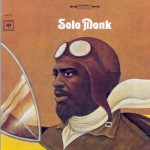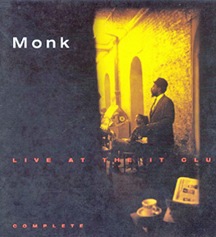Monk Alone: The Complete Columbia Solo Studio Recordings 1962-1968, Columbia/Legacy (C2K65495); Live at the It Club Complete Columbia/Legacy (C2K65288)
©Laurence Svirchev
 Thelonious Sphere Monk was his given name at birth. He had a nickname that was used pejoratively in the press of the time: Melodious Thunk. But my opinion is that melodious thunk appropriate since it is as close as the English language can get to describing his sound. It took years for the jazz world to treat Monk’s music as anything other than weird and incomprehensible; only a handful of musicians and fans had a clue to what he was doing from the mid-1940s to the mid 1950s.
Thelonious Sphere Monk was his given name at birth. He had a nickname that was used pejoratively in the press of the time: Melodious Thunk. But my opinion is that melodious thunk appropriate since it is as close as the English language can get to describing his sound. It took years for the jazz world to treat Monk’s music as anything other than weird and incomprehensible; only a handful of musicians and fans had a clue to what he was doing from the mid-1940s to the mid 1950s.
But he didn’t care. He just did what he did. In fact, he once said, “I say, play it your own way. Don’t play what the public wants. You play what you want and let the public pick up on what you are doing, even if it takes then 15 or 20 years.” It takes guts to have such self-confidence.
Yet while listening to his 1962-68 solo recordings, now three decades old, one is struck by the simplicity of his playing. There is nothing overtly complicated about his work. The left hand plays the bass line, often in a stride style, and the other hand plays the melody. Almost all the cuts are standards, a bit of a surprise because Monk was a prolific composer. And they are mostly performed a medium tempo. He had been playing this way for almost 15 years, yet in that period, some went so far as to say he couldn’t play music.
Not true. He had played Afro-American spiritual music for years. Saxophonist Johnny Griffin reported that Monk could play as fast as Art Tatum, but just wasn’t interested in his sound. Fundamentally, Monk never changed. He just was, a menhir from time immemorial. So what was so different about Monk, and why buy this set?
Because of his knowledge of music ran deep, Monk meticulously plays the history of jazz piano. His melodious interpretations of “Body and Soul” or “Between the Devil and the Deep Blue Sea” are musically flawless. Perfect diamonds, emeralds, and a ruby. “Ruby, My Dear” is an ode to a first girl friend, a hummable ballad, a melody so beautiful you know it’s about love.
Because of the Thunk. This is the part that throws people used to jazz conventions. Let’s leave it to German musicologist Thomas Fitterling to explain Thunk. Fitterling analyzes Monk’s sound as having a “peculiarly disharmonious harmony.” Monk also gave the impression of doing the impossible: bending piano notes.. Fitterling explains: “Two notes of an interval are rarely played at equal volume. More often they are struck with different intensity…creating the impression Monk is gliding from note to note.” Listen to any cut on these two CDs. You will hear exactly what Fitterling describes, gratis of the excellent re-mastered sound.
 With his Quartet’s Live at the It Club in 1964, Monk originals dominate. According to French pianist and author Laurent de Wilde, most of the tempos are 140-160 beats per minute (why does it take Europeans to write definitive musical biographies of an American genius?). Disc one opens with “Blue Monk.” After Monk delivers his melodic statement, Charlie Rouse is heard on a tenor saxophone solo. But in reality there are two solos going on: Monk does not simply feed chords to Rouse, he plays a clunky counterpoint solo to Rouse’.
With his Quartet’s Live at the It Club in 1964, Monk originals dominate. According to French pianist and author Laurent de Wilde, most of the tempos are 140-160 beats per minute (why does it take Europeans to write definitive musical biographies of an American genius?). Disc one opens with “Blue Monk.” After Monk delivers his melodic statement, Charlie Rouse is heard on a tenor saxophone solo. But in reality there are two solos going on: Monk does not simply feed chords to Rouse, he plays a clunky counterpoint solo to Rouse’.
He’s got a percussively dissonant thing going, laying out for a bar or two, then jumping back in. It stretches, elasticizes the feel even thought the rhythm section does not deviate a flea-hop from the basic pulse. When Monk does take the overt solo he doesn’t sound much different from when he was backing Rouse. He constantly varies the pace, stopping mid-arpeggio for an endless moment and then continues the arpeggio from where it left off. Break for a Larry Gales bass solo and then Ben Riley drum solo, lovely because such solos are rarely found on a Monk studio session.
Try the onomatopoetically-titled “Ba-lue Bolivar Ba-lues Are” on disc two. First you’ll hear the introductory notes to another Monk composition “Rhythm-A-Ning,” a pause in which Monk seems to change his mind about what to play, and then Ba-lues. The head is played collaterally by Monk and Rouse; Rouse solos and then it is Monk’s turn. What he plays is not ambidextrous, but a Monk trademark. He starts with a series of chords that deftly changes to one finger striking individual keys moving up, then down the keyboard. When he resumes playing with the whole hand, he accents on or two keys at the most, leaving enough space between tones to hear the ringing aftermaths. Leaving space creates tension. Letting the notes settle relieves tension.
It’s a unique approach, and that is the most important thing about Monk. Not only did he play at the highest creative levels, but he had a language of his own. Lots of people play Monk compositions, and most of them homogenize the sounds, smoothing the quirkiness out of the music. The remainder do what they are supposed to- make their own weird interpretations.
Originally published in Planet Jazz, Montréal, Spring 1999.
Author’s 2010 Note: The above-mentioned musical biographies of Monk are landmarks. A third book to complement the understanding of Monk and his musical times is “The Thelonious Monk Reader (Edited by: Rob van der Bliek, Oxford University Press 2001). A comprehensive, academic yet eminently readable biography has finally been published: “Thelonious Monk: The Life and Times of an American Original” by Robin Kelley on Free Press (2009). Kelley, an Afro-American with marvelous insight into American social conditions, complements Fitterling’s & de Wilde’s musical commentaries. Most importantly, it is the definitive biography of Monk himself. It is also an amazing commentary on the life an artist with two strikes operating against his endeavours: racism and mental disease.